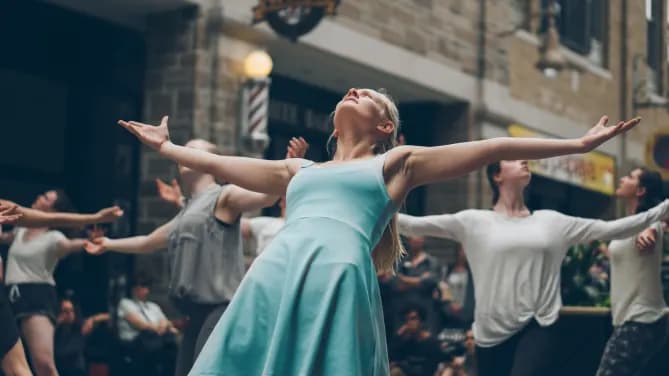... 5, 6, 7, 8 Duties of a Choreographer
Professional dance companies, Broadway musicals, tap class at the local community center, your teenager’s high school… these are all places choreographers work and make art. The style of dance they create varies depending on the needs of the company they work with. Regardless, choreographers are highly skilled, creative professionals who help tell stories, evoke feelings and have fun with movement.
{{COMPANY_AD_STANDALONE}}}
What does it mean to be a choreographer?
A choreographer is responsible for designing dance and movement. In many cases, this is in the context of a larger production. That might be a musical, a ballet or a concert that combines several pieces from one or more choreographers. Sometimes, a choreographer works with a company to help support a small moment on stage that requires dance or movement. And let’s not forget the special folks who teach dance classes to children. They don’t get nearly enough credit for choreographing dances that young people can shine in. No matter where a choreographer works, they need a certain amount of passion for dance, as well as the ability to teach large groups of people efficiently and effectively.
Main duties and responsibilities.
1. Understanding the needs of the piece.
2. Collaboration.
3. Storytelling.
4. Creating the dances.
5. Teaching.
6. Recognizing the skills and limitations of performers.
7. Time management.
8. Safety.
Choreographer career path.
A choreographer is often a dancer in their own right. They may have performed with a dance company or as a musical theatre actor for a time. For a variety of reasons, other choreographers skip that time on stage and go straight to making dances for other people to perform. Generally, a choreographer will start out working as an assistant for a more seasoned professional before taking on the role of choreographing an entire show or concert on their own.
Required education, skills and training.
A choreographer knows a lot about a lot of different kinds of dances. While they tend to specialize in one style or another, choreographers need to know about a variety of techniques and traditions so they can best honor the story they’re trying to tell. The training never stops, and even the most seasoned choreographer continues to take dance classes and study to expand their knowledge.
Most choreographers who do that work as their main source of income have spent years of their lives training in dance classes, and many of them have degrees in performance. Depending on the kind of choreography someone is interested in, they might seek out a career in dance performance, dance education or musical theatre.
There’s a lot of time that goes into learning as much as possible about the art of dance as well as how the human body functions. Dancers and choreographers who earn college degrees are required to take courses in kinesiology and anatomy so they understand the complexities of creating movement.
Choreographers also tend to know a lot about music, and a choreographer for musical theatre can usually read music pretty well, too.
How much do you pay a choreographer?
As with any job, the pay varies with the scale of the work. A choreographer who pops into one rehearsal for a couple of hours to help clean up a tiny little moment would make about $100 for the evening. Choreographing an entire musical should be much more lucrative. Your local high school isn’t going to pay as much as, say, a Broadway production. However, choreographing a show is a huge job. Fees can range from hundreds to tens of thousands of dollars.
--
Leslie W. Price is a theatre artist, educator, and writer living in the San Francisco Bay Area. Find her on LinkedIn or visit her portfolio.
Don’t miss out on articles like these. Sign up!
Why women love us:
- Daily articles on career topics
- Jobs at companies dedicated to hiring more women
- Advice and support from an authentic community
- Events that help you level up in your career
- Free membership, always
